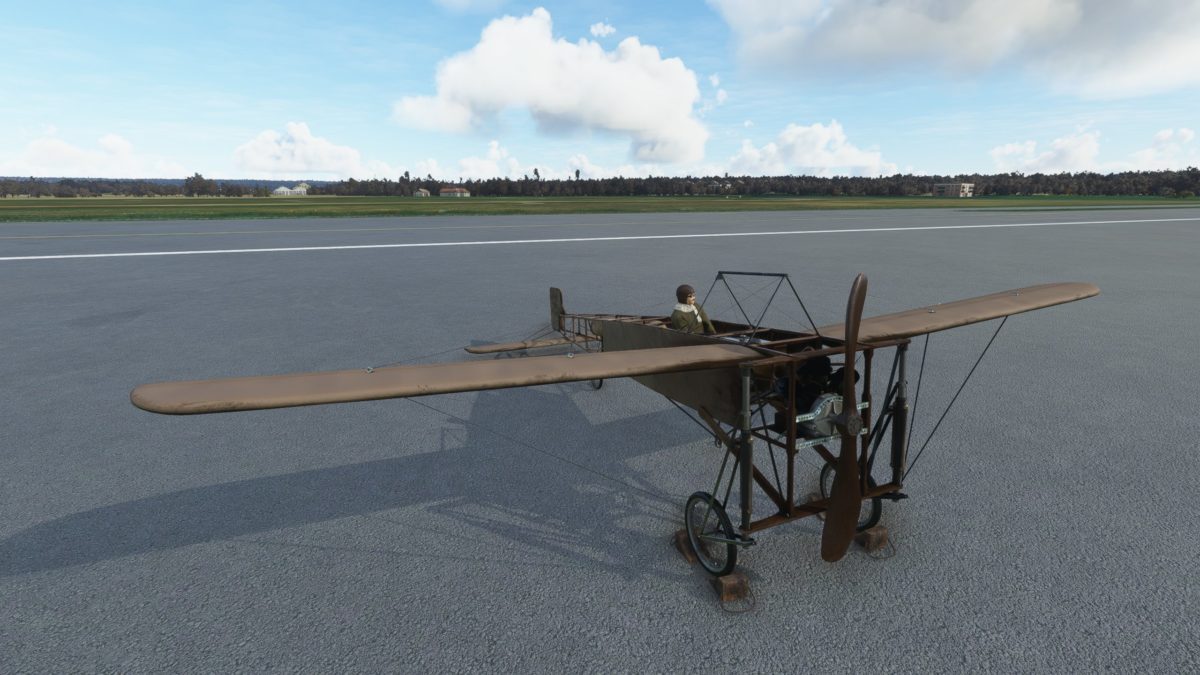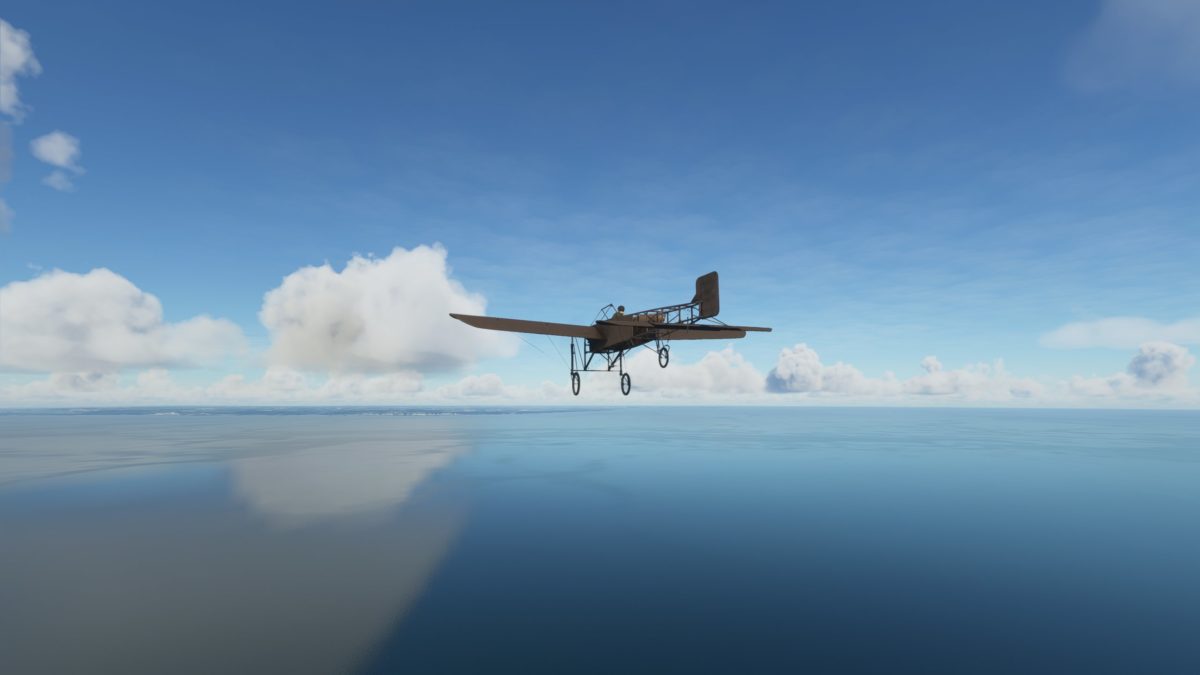January 17, 2023
Today I reenacted French aviator Louis Blériot’s historic 1909 crossing of the English Channel, in Microsoft Flight Simulator.

Louis Blériot was a French engineer who invented the first practical headlight for automobiles. After building a successful headlight business, he turned his attention to the experimental field of aviation.

The Blériot XI, built in 1909, was the result of several years of experiments, encouraged further by the public demonstration of the Wright Flyer flown by Wilbur Wright in Paris the previous year, to great acclaim.

Like the Wright Flyer, the Blériot XI used “wing warping” to control roll. Instead of using ailerons (a later adoption), wires pulled the flexible wood-and-fabric wing and altered its shape. Compare the screenshots below:


As you can see, there no instruments. No airspeed indicator, no altimeter, not even a fuel gauge. But it was the first airplane to adopt the “stick” along with a foot board for controlling the rudder.

Before tackling the Channel, I took some practice flights from a grass airstrip just next to the Palace of Versailles. The first thing I learned is you cannot taxi this machine. It has to be positioned for takeoff on the runway.

The Blériot XI is powered by a 25 horsepower engine designed by Italian-born motorcycle racer Alessandro Anzani, with three piston cylinders arranged in a semi-radial design.

The very first thing I notice, on getting airborne, is that the torque from the propeller will always make you turn to the left, even while in flight, unless you constantly apply some right rudder.

After making an involuntary circle to the left, pulled by the torque, I put it down on the runway where I started. I guess that’s one way to do it.

But I soon got aloft again, better prepared to control the aircraft the second time around.

As I’ve read about the Wright Flyer, the wing warping really exists more to control the wings and keep them level. To turn, you mostly use the rudder.

The control responses lag. Once you get started on a turn, in either direction, it takes some time to work your way out of it.

Everything is about slow and steady. No abrupt movements, no overcorrections.

So on my second flight, I was actually able to maneuver the Blériot XI around a typical (in this case right) traffic pattern, with the airstrip here off to my right.

Turning from base to final.

I pretty much just cut the power at this point and glide in. If you’re flying, you’re pretty much full throttle. If you’re landing, you’re pretty much power off.

Alright, so I didn’t kill myself – twice – so like Blériot must have, I’m feeling pretty confident about tackling the English Channel.

On the morning of July 25, 1909, Louis Blériot took off from a beach near Calais, France. This is the closest small airport, just outside of Calais.

The big question I have is how much fuel I’m going to burn going across the Channel. I presume he had enough, but what his cushion was, I have no idea. And there’s no fuel gauge to tell me.

Well, you know, there’s only one way to find out. I’m off.

Blériot flew at an altitude of about 250 feet, but – not necessarily by intent – I’m already a bit higher than that, probably around 1,000 feet. It seems to work, so I’ll try to hold it here.

There’s Calais, off to my right. Did I mention that the Blériot XI doesn’t have a compass? So like Blériot, I need to just point myself in the general direction of where I think England must be.

I’m using the clouds to keep my heading straight. With the torque, it would be easy to drift either left (too little rudder) or right (too much) without realizing it.

Blériot himself followed a ship across the Channel, though he quickly overtook it and had to manage on his own.

Put put put put. That’s the sound that the engine is making, alone over the Channel.

Blériot flew at about 45 mph, or 72 km/h. I can’t tell right now – I don’t have an airspeed indicator – but my time will eventually show that I’m doing about the same, at full throttle.

Soon after passing the ship, Blériot could see the English coast on the horizon ahead. There it is. Glad it’s a clear day.

Unlike me, Blériot found himself getting pushed east by the wind, and had to double back a bit towards Dover.

Looking back at my tail (and towards France), you can see the right rudder I have to keep in just to stay straight.

Blériot didn’t have quite the same visibility I do: “for more than 10 minutes I was alone, isolated, lost in the midst of the immense sea, and I did not see anything on the horizon or a single ship”.

Blériot couldn’t wait for ideal weather, because there were several rival French aviators prepared to take off and compete for the £1,000 prize offered by the Daily Mail, for the first to cross the Channel.

Looks like I’m roughly on course. Those are the White Cliffs of Dover up ahead.

You can just barely see the coast of France behind me now.

In fact, I’m dead on target. That’s the port of Dover to my left, with Dover Castle overlooking it.

As Blériot approach the English coast, he had someone positioned atop the Cliffs of Dover waving a French flag to help show him where to land.

With no one waving a flag to help me, I need to pick out a nice field to land.

Blériot actually landed right next to Dover Castle, just ahead to the left, and there’s a little monument there today to indicate where. But there’s a copse of trees there now, so I need to find a different spot.

That nice long open green field to the right will do.

I’ve cut the power and am gliding in.

My wheels touched down fine, but at these low speeds the rudder has barely any control, so I started to ground loop and ended up gently on my right wing.

But I don’t feel too bad. When Blériot landed in 1909, he made a hard “pancake” landing, damaging his landing gear and his propeller. Obviously, nobody cared. He had just completed the first international flight in history.

Blériot’s flight took 36 minutes and 30 seconds. My flight took just over 38 minutes, but I started a bit further inland than he did, and didn’t need to jog back west (to counter being blown off course) or circle before landing.

The scene of Blériot’s landing in England, in 1909.

Blériot built about 900 aircraft for the French Army before World War I, mostly on the Blériot XI model. He later headed SPAD, which produced more advanced biplanes as the war progressed.

Blériot died in 1936, but not before personally welcoming Charles Lindbergh to Paris after the latter’s similar landmark flight across the Atlantic Ocean in 1927.

Love this story !
Thank you .
God bless these aviaters!!
What a great story!!!!!!!!! These guys really new how to Fly!!!